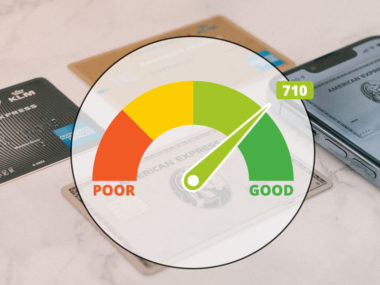We focus a lot on credit score information here at Fiscal Tiger. Your credit score can be the difference between a $300,000 home or a $130,000 home. It can also determine your eligibility for a new car, or being offered a new job.
Our credit scores can leave a major impression on our lives, which is why every new change to reporting or score calculation that happens can be so dramatic. Will it hurt your score? Or will your score see a boost? Why do updates happen in the first place, and are these changes immediately apparent to a lender?
Let’s dive into the latest changes to FICO and VantageScore — FICO9 and VantageScore 4.0, respectively — and see what all the hype is about. It could be that these new changes are just what your score has been waiting for …
FICO 9 Updates
Your FICO score is the figure most widely used by lenders to determine your standing, and it is based on individual consumer analysis provided by the three major credit bureaus. FICO creates a variety of different scores that are dependent on specific industries: from car, to mortgage, credit card, and the more widely used basic score model. These industry specific scores can come in handy for when you’re determining your eligibility for a particular loan.
For example, if you’re buying a new car you would want to look at the FICO Auto Loan Score, which will factor in specific risk-factors to help determine a more accurate score for an auto loan. The baseline of these industry-specific formulas are all the same — based on the model created by FICO in 1986 — but they incorporate unique risk factors that pertain to every industry.
The same goes for every update in the FICO formula. The underlying foundation is always the same, but specific nuances change just slightly that reflect consumer behaviors and new risks. So far, there have been eight updates, with the ninth one coming this fall.
In the latest version (commonly referred to as FICO 9), FICO states that there are three major changes happening that will affect your score:
- Third-party collections that have been paid off no longer have a negative impact
- Medical collections are treated differently than other types of debt. Unpaid medical collections will have less of a negative impact on FICO Score 9.
- Rental history, when it’s reported, factors into the score—this may be especially beneficial for people with a limited credit history
Along with these FICO 9 updates will be two industry specific updates: Auto Score 9 and Bankcard Score 9.
How Will This Affect My FICO Score?
However, there is a catch: With every FICO update comes a slow transition for lenders.
Not all lenders will be using this new update to determine your application for a loan. Some lenders will still be using older models; even as far back as the second, third, or fourth FICO update. FICO only has the ability to create new models that reflect the most recent data and consumer habits, but they do not have the ability to force lender’s hands to use the most recent model. That decision is always left to the lender, as they may feel it’s the best option for their customers.
In this way, this new FICO score update might not affect your lending options at all. You can ask your lender what model they use and why.
However, there are a handful of lenders that are switching to the new model, and more lenders may switch as time goes on. Most likely this is because the changes to how medical debt and collections are represented might be more accurate for lenders.
In America, the most common form of collections debt is medical related, and many people with medical debt have no other history of collections or bad credit. Unfortunately for many who have medical debt, it doesn’t matter how diligent you are at protecting your credit score, accidents can happen easily and can get expensive quickly. That is why FICO made their decision to calculate those specific accounts in collections with less weight, and why many lenders are now considering the new model.
If you have medical or third-party collection debt, chances are you may see a slight improvement in how your score is reflected on FICO. Additionally, rental reporting could help many people with little-to-no credit history get off on the right foot. Hopefully more lenders will begin to adopt this useful new FICO scoring model, so they can understand a more accurate reflection of your credit portfolio.
VantageScore 4.0 Changes
VantageScore is not the most common method of credit score calculation used by lenders, but it is a popular new method that a handful of banks and lenders utilize. It has some unique benefits, and it can be just as important to maintain as your FICO score. Unlike FICO, VantageScore does not have industry specific scores, but instead tries to put more weight on trending data.
Trending data is the culmination of your credit history over time. The opposite of this is static data, which looks at your current debt and determines your score off of a single snapshot of your current credit standing, without taking into consideration the fluctuations of that debt or your behavior over time. VantageScore believes that the fluctuation of your debt over time is vital to understanding your credit risk to lenders, and has thus factored it into your overall score.
With the newest update, VantageScore notes that they will be making similar changes to their model as FICO will be making in the fall. According to VantageScore, those changes include:
- Less emphasis on medical collections and other derogatory and public-records data (such as tax-liens or third-party collections)
- More reliance upon “trended data” rather than static data (this means they will look at your past history of paying off debt (trending), instead of determining your score based on the debt you have at that moment (static))
- Use of machine learning to create better scores for people with limited credit data (this could mean reviewing cell phone payments, rental payments, utilities, etc.)
How Will This Affect Your VantageScore?
Just like FICO, not all lenders will be willing to switch to the new VantageScore model, and some may stick with an older version for some time. However, most lenders that use VantageScore will most likely see the benefit in adapting to the new model, as it will greatly improve the accuracy of many consumer’s scores.
By not weighting medical collections accounts equally to more conventional forms of debt, VantageScore will also be able to help out those with severe medical debt by ignoring recent claims. This will allow consumers the chance to pay off those claims before they affect their score.
Additionally, the switch from trending data to static data could be very beneficial for those with an excellent credit history. However, on the flip-side, if you are someone who is looking to repair your credit in a fast manner by paying off debt, opening new accounts to decrease your utilization ratio, or consolidating your debt, this new change will actually make it more difficult to quickly improve your score.
Nick Clements with Forbes Magazine shared some insight on this new change in an article from March 2017: “Trended data makes sense, but it will also make it a little more difficult for a quick improvement in your credit score. Only consistently good behavior over time can help you get the best score.”
As for the last bullet point — the use of machine learning — this will be new territory for both VantageScore and FICO. In recent news, FICO has used AI interfaces to create what is known as FICO XD: a personalized scoring model for those people who have little to no credit history, which looks at utility bills, cell phone payments, or other bills to make an educated guess at a consumer’s credit standing. However, it has never been used in the standard FICO scoring model. For VantageScore to take this big leap and include it in their main model is a daring move. It could be either an exciting and worthwhile change, or a total flop. Only time will tell how AI interfaces will really affect your credit score.
A New Focus on Accuracy
One can hope that both FICO 9 and VantageScore 4.0 will quickly be adapted by lenders around the United States. These new changes to how medical bills and collections are treated could be a major benefit to millions of Americans who are plagued with unpredictable medical expenses. Thankfully, FICO and VantageScore have stepped up to offer a helping hand to consumers who need it.
Additionally, many of the other changes will help lenders forecast a more accurate determination of any consumer’s credit history. These modern updates will hopefully lead to even more advanced changes down the road, as AI proves to be either beneficial or detrimental to the new VantageScore 4.0 algorithm. Until then, you could see some minor changes in your credit score, but don’t expect anything too dramatic.
These two credit score leaders will continue to fine tune, update, and change their scoring model, but you can always expect the foundations to stay the same. Continue with those positive credit building habits, and you too could see a beneficial change to your credit score over time.
What else factors into your credit score? Find out at our credit score resource center.
Image Source: https://depositphotos.com/





